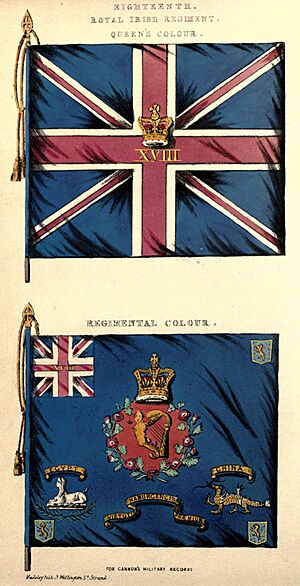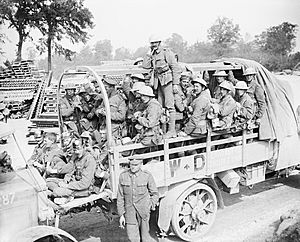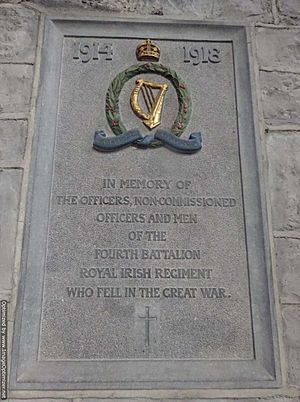Royal Irish Regiment (1684–1922) facts for kids
Quick facts for kids 18th Regiment of Foot18th (Royal Irish) Regiment of Foot Royal Irish Regiment |
|
|---|---|
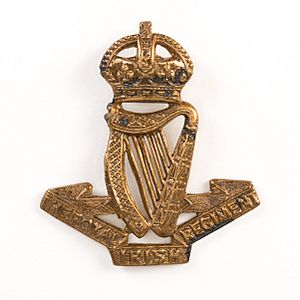
Royal Irish Regiment Cap Badge
|
|
| Active | 1684–1922 |
| Country | |
| Branch | |
| Type | Infantry |
| Role | Line infantry |
| Size | 2 Regular battalions 3 Militia and Special Reserve battalions |
| Garrison/HQ | Kickham Barracks, Clonmel |
| Nickname(s) | The Namurs, Paddy's Blackguards |
| Motto(s) | Virtutis Namurcensis Praemium (Reward for Valour at Namur) |
| Colors | Royal Blue |
| March | Quick: Garry Owen |
| Engagements | Second Boer War |
| Disbanded | 1922 |
The Royal Irish Regiment was a famous infantry (foot soldier) group in the British Army. It started in 1684 and was known as the 18th Regiment of Foot until 1881. This regiment was one of several "Irish" groups, mainly recruiting soldiers from Ireland. Its main base was in Clonmel.
The regiment served for over 250 years. It was disbanded in 1922 when Ireland became independent. This happened because five regiments, including the Royal Irish, had their traditional recruiting areas in the new Irish Free State.
Contents
History of the Royal Irish Regiment
Early Years and Famous Battles
The regiment began in 1684. It was created by the Earl of Granard from smaller groups of soldiers in Ireland. At first, it was called Hamilton's Foot.
The regiment fought in Flanders during the Nine Years War. In 1695, they helped capture a fort called Terra Nova at the Siege of Namur. This brave act was even mentioned in the song 'The British Grenadiers'. Because of their courage, King William III renamed the unit The Royal Regiment of Foot of Ireland.
After a peace treaty in 1697, the regiment stayed together. When the War of the Spanish Succession started in 1701, they returned to Flanders. They fought in many big battles with Marlborough's army. These battles included Schellenberg, Blenheim, Ramillies, Oudenarde, and Malplaquet.
Garrison Duties and American War
After the war ended in 1713, the regiment was stationed on the island of Menorca until 1742. They also sent a small group to Gibraltar in 1727. For the next 25 years, they mostly served as guards in Britain and Ireland.
In 1751, rules changed, and units were no longer named after their commanders. The regiment officially became the 18th Regiment of Foot. In 1767, they went to North America. They spent eight years guarding areas in Philadelphia and Illinois.
When the American War of Independence began in 1775, most of the unit was in Boston. They fought in their first battles in over 50 years at Lexington, Concord, and Bunker Hill. In 1776, they left Boston and went to Nova Scotia, then to England.
In 1782, the regiment moved to Guernsey. There, they helped local soldiers stop a mutiny by another regiment. They were publicly thanked and given a reward. Later that year, they returned to Gibraltar. They stayed there until 1793, when they joined the Siege of Toulon during the French Revolutionary Wars.
19th Century Adventures
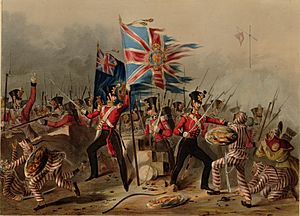
The regiment also fought in the Battle of Alexandria in Egypt in 1801. During the Napoleonic Wars, one part of the regiment served in Jamaica and another in Curaçao.
Sadly, in 1807, 120 soldiers from the 18th Regiment drowned when their ship, the Prince of Wales, sank in Dublin Bay.
Later, the regiment saw a lot of action during the First Opium War in China. They fought in many battles between 1840 and 1842. These included the Capture of Chusan, Canton, Battle of Amoy, and Battle of Chinkiang.
They also took part in the Siege of Sevastopol during the Crimean War. Captain Thomas Esmonde won the Victoria Cross for saving his comrades from a fire. The regiment also fought in the Second Anglo-Afghan War.
In 1857, a second part of the regiment was formed. From 1863, they arrived in New Zealand and fought in the New Zealand Wars. Captain Hugh Shaw also won the Victoria Cross there for rescuing wounded soldiers.
In 1881, the regiment officially became The Royal Irish Regiment. It was the main regiment for the counties of Tipperary, Waterford, Wexford, and Kilkenny.
The 1st Battalion served in British India and Afghanistan from 1875 to 1884. Then, they went to Egypt. From 1899, they were sent to South Africa to fight in the Second Boer War. They played an important role in the Battle of Slabbert's Nek in 1900. The 2nd Battalion fought in Egypt in 1882 and then served in Malta and India.
First World War Service
Regular Army Battalions
The 1st Battalion arrived in France in December 1914 to fight on the Western Front. Later, they moved to Salonika in November 1915.
The 2nd Battalion arrived in France in August 1914. They were almost completely destroyed at the Battle of La Bassée in October 1914. Many soldiers were taken as prisoners. The battalion was rebuilt and fought again at the Battle of the Somme in 1916. There, they helped capture three miles of German trenches.
The 3rd (Reserve) Battalion was mostly made up of soldiers from Dublin. They were the first army troops to fight the Irish rebels during the Easter Rising in Dublin. The rebels were trying to create an independent Irish Republic. Eight soldiers from the Royal Irish Regiment were killed, and sixteen were wounded.
New Army Battalions
During the war, new battalions were formed. The 5th (Service) Battalion landed in Suvla Bay in August 1915. They later moved to Salonika. The 6th (Service) Battalion landed in France in December 1915 to fight on the Western Front. The 7th (South Irish Horse) Battalion was formed in France in September 1917.
Disbandment of the Regiment
After the First World War, there were big cuts to defence spending. Also, the Irish Free State was established in 1922. Because of these changes, it was decided that six regiments from Southern Ireland, including the Royal Irish Regiment, would be disbanded.
On June 12, 1922, five regimental flags (called colours) were placed in a special ceremony at Windsor Castle. King George V was there. All six regiments were officially disbanded on July 31, 1922. Many former soldiers and officers from these regiments joined the new National Army of the Irish Free State. They brought valuable fighting experience with them.
Battle Honours
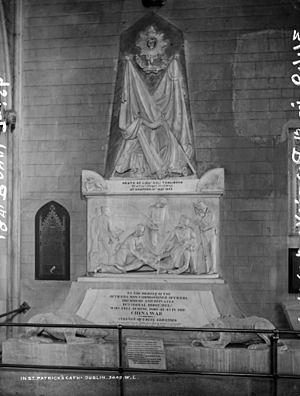
Battle honours are special awards given to military units for their bravery in battles. The Royal Irish Regiment earned many battle honours, including:
- Early Wars: Namur 1695, Blenheim, Ramillies, Oudenarde, Malplaquet, Egypt, China, Pegu, Sevastopol, New Zealand, Afghanistan (1879–80), Tel-el-Kebir, Egypt 1882, Nile (1884–85), South Africa (1900–02)
- The Great War (First World War): Mons, Le Cateau, Retreat from Mons, Marne 1914, Aisne 1914, La Bassée 1914, Ypres 1915 '17 '18, Gravenstafel, St Julien, Frezenberg, Bellewaarde, Somme 1916 '18, Albert 1916 '18, Bazentin, Delville Wood, Guillemont, Ginchy, Messines 1917, Pilckem, Langemarck 1917, St. Quentin, Rosières, Arras 1918, Drocourt-Quéant, Hindenburg Line, Canal du Nord, St Quentin Canal, Beaurevoir, Cambrai 1918, Courtrai, France and Flanders 1914–18, Struma, Macedonia 1915–17, Suvla, Landing at Suvla, Gallipoli 1915, Gaza, Jerusalem, Tell 'Asur, Megiddo, Nablus, Palestine 1917–18
Victoria Cross Heroes
The Victoria Cross is the highest award for bravery in the British military. The following members of the Royal Irish Regiment were awarded this honour:
- Captain Thomas Esmonde, for bravery in the Crimean War
- Captain Hugh Shaw, for bravery in the New Zealand Wars
- Private John Barry, for bravery in the Second Boer War
- Private (Acting Lance-Corporal) Frederick George Room, for bravery in the First World War
Great War Memorials
There are several memorials dedicated to the soldiers of the Royal Irish Regiment who died in the Great War (World War I):
- Irish National War Memorial Gardens, Dublin, Ireland.
- Island of Ireland Peace Park Messines, Belgium.
- Ulster Tower Memorial Thiepval, France.
- Menin Gate Memorial Ypres, Belgium.


